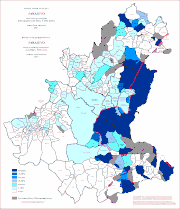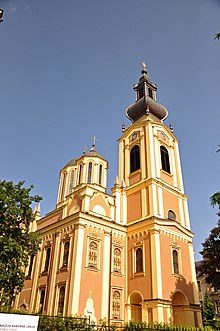Serbs in Sarajevo
| Part of a series on |
| Serbs |
|---|
 |
The Serbs of Sarajevo numbered 157,526 according to the 1991 census, making up more than 30% of the Sarajevo Metropolitan area (10 pre-war municipalities; Centar, Stari Grad, Novo Sarajevo, Novi Grad, Ilidza, Ilijas, Vogosca, Hadzici, Trnovo, and Pale. Today, following the Bosnian War, few Serbs remain in central areas of Sarajevo; however, many parts of the pre-war metropolitan area are now forming the city of East Sarajevo in Republika Srpska; namely, Pale RS, East Ilidza, East Novo Sarajevo, Trnovo RS, and East Stari Grad. Most have either moved abroad, to Serbia or other countries, or moved to a new settlement on the outskirts of Sarajevo, located in the Republika Srpska, known as East Sarajevo (previously Srpsko Sarajevo - Serbian Sarajevo).
Churches[]
There are three main Serbian Orthodox places of worship in Sarajevo: the Old Orthodox Church (Serbian: Стара православна црква or Stara pravoslavna crkva), dating back to the 16th century,[1] the Cathedral Church (Саборна црква or Saborna crkva), which was erected in the 1860s, and the Church of Sveto Preobraženje in Novo Sarajevo.
Notable people[]












Notable Serbs who were born in or lived in Sarajevo include:
- , merchant
- Sima Milutinović Sarajlija
- (Đorđe Nikolajević), theology professor, Orthodox priest, and monk, Dabar-Bosnia Metropolitan bishop (1885-1896)
- Jovan Marinović, politician and diplomat, Principality of Serbia President of the Ministry (1873-1874)
- , merchant and industrialist
- , merchant
- , fur merchant
- , fur merchant
- , schoolteacher, dramaturgist, and translator
- , theologist, schoolteacher, Orthodox priest, and monk, Dabar-Bosnia Metropolitan bishop (1881-1885)
- (Petar Mandić), theologist, Orthodox priest, and monk, Dabar-Bosnia Metropolitan bishop (1896-1907)
- , merchant, industrialist, and politician, Hotel Evropa owner (1882-1927)
- (Manojlo Letica), lawyer and Orthodox monk, Dabar-Bosnia Metropolitan bishop (1907-1920)
- Nikola T. Kašiković, writer and publisher, Bosanska vila owner and editor-in-chief
- (Jovan Zimonjić), theology professor and Orthodox monk, Dabar-Bosnia Metropolitan bishop (1920-1941), canonized as hieromartyr in 1998
- , tobacco merchant, historian, geographer, and SANU academician
- (Nikola Krulj), Juris Utriusque Doctor, theology professor, and Orthodox monk, Dabar-Bosnia Metropolitan bishop (1951-1966)
- Jevto Dedijer, geographer
- Vojislav "Đedo" Kecmanović, Balkan Wars volunteer soldier, World War II Partisan, and post-war communist politician
- Lazar Drljača, painter
- , merchant, industrialist, and juris doctor, Hotel Evropa owner (1927-1941)
- Bogdan Žerajić, revolutionary
- Veljko Čubrilović, Young Bosnia revolutionary
- , painter
- , painter
- , theater actress
- Stanko Karaman, biologist
- Vladimir Gaćinović, writer and revolutionary
- Danilo Ilić, Young Bosnia revolutionary
- , surgeon and football pioneer
- , theater actress
- Gavrilo Princip, Young Bosnia revolutionary
- Nedeljko Čabrinović, Young Bosnia revolutionary
- Dobroslav Jevđević, politician and World War II Chetnik leader
- Trifko Grabež, Young Bosnia revolutionary
- Cvjetko Popović, Young Bosnia revolutionary
- , Young Bosnia revolutionary and historian
- Roman Petrović, painter
- Vaso Čubrilović, Young Bosnia revolutionary
- Jezdimir Dangić, Young Bosnia revolutionary, lawyer, Yugoslav Gendarmerie sub-lieutenant, and World War II Chetnik
- Đuro Pucar, World War II Partisan leader and post-war communist politician
- Rodoljub Čolaković, World War II Partisan leader and post-war communist politician
- , World War II Partisan
- Vlado Šegrt, World War II Partisan leader and post-war communist politician
- , World War II Partisan
- , World War II Partisan leader
- Erih Koš, lawyer and writer
- (Vojislav Mitrović), schoolteacher, theology professor, and Orthodox monk, Dabar-Bosnia Metropolitan bishop (1967-1992)
- , Mechanical and Energetics Engineer
- , World War II Partisan
- Slobodan "Seljo" Princip, World War II Partisan leader
- , World War II Partisan
- , World War II Partisan leader and post-war communist politician
- , World War II Partisan
- Milan Rajlić, football player
- , World War II Partisan
- , World War II Partisan
- Vladimir "Valter" Perić, World War II Partisan leader
- , World War II Partisan
- Ljubo Kojo, World War II Partisan, mayor of Sarajevo 1955-1962
- , World War II Partisan, mayor of Sarajevo 1962-1963
- , World War II Partisan leader
- , World War II Partisan
- Branko Stanković, footballer and football coach
- Vaso Radić, World War II Partisan, mayor of Sarajevo 1963-1965
- , World War II Partisan, post-war communist politician, and state-appointed business manager (CEO of Energoinvest)
- Aleksandar "Aca" Nikolić, basketball coach
- , electrical engineer, mayor of Sarajevo 1973-1975
- Milorad Ekmečić, historian
- Milanko Renovica, communist politician
- (Gojko Mrđa), theologist and Orthodox monk, Dabar-Bosnia Metropolitan bishop (1992-present)
- Nikola Milošević, political philosopher
- Predrag Palavestra, writer and literary historian
- Biljana Plavšić, biologist and politician, convicted for crimes against humanity
- , actor
- Duško Trifunović, poet and writer
- Obrad Piljak, banker and communist politician
- Boro Drašković, playwright and film director
- Predrag Golubović, film director
- Dimitrije Bjelica, chess player
- Nikola Koljević, scholar and politician
- Momo Kapor, writer
- Uglješa Uzelac, economist and sports administrator, mayor of Sarajevo 1983-1985
- Svetozar Vujović, football player
- , surgeon, UofS medical faculty dean (1988-1992), UIS medical faculty dean (1993-2005), UIS rector (2000-2005)
- Kornelije Kovač, musician and composer
- Boško Antić, football player and football coach
- Momčilo Krajišnik, politician, convicted for crimes against humanity
- , poet
- Blagoje Brati��, football player and football coach
- Nenad Kecmanović, academician
- Vladimir "Čobi" Savčić, singer
- Braco Dimitrijević, artist
- Svetislav Pešić, basketball player and basketball coach
- , politician
- , structural engineer
- Milić Vukašinović, musician
- Goran Bregović, musician
- Neda Ukraden, singer
- Božo Janković, football player
- Zdravko Čolić, singer
- Slobodan "Čobo" Janjuš, football goalkeeper
- Mila Mulroney, First Lady of Canada 1984-1993
- Želimir "Keli" Vidović, football player
- Vojislav Šešelj, politician
- , dramaturgist and theater director
- Emir Kusturica, film director
- Ipe Ivandić, musician
- Nikola Nikić, football player
- , journalist
- Ljiljana Smajlović, journalist, Politika editor-in-chief 2005-2008, 2013-present
- Ratko Radovanović, basketball player and basketball administrator
- , plastic, reconstructive, and hand surgeon, Klinikum Bogenhausen
- Boris Tadić, President of Serbia 2004-2012
- Dragan Đokanović, politician, physician, sportsman
- Predrag Pašić, football player
- Željko Lukajić, basketball coach
- Vladimir Pištalo, writer, 2008 NIN Prize winner
- Vlado Čapljić, football player
- Dragan Škrba, football goalkeeper
- Nele Karajlić, singer, actor, and TV personality
- Nebojša Novaković, football player and football coach
- Vesna Mišanović, chess player
- , film and television director
- Srđan Koljević, screenplay writer and film director
- Isidora Bjelica, writer
- Dragan "Maca" Marinković, actor and TV presenter
- Predrag Danilović, basketball player, KK Partizan president 2007-present
- Rade Bogdanović, football player
- , novelist
- Ognjen Tadić, politician
- Haris Brkić, basketball player
- Goran Trobok, football player
- Nenad Mišković, football player
- Dušan Vukčević, basketball player
- , basketball player
- Veselin Petrović, basketball player
- Neven Pajkić, boxer
- Ognjen Koroman, football player
- Ognjen Aškrabić, basketball player
- Đorđe Babalj, football player
- Aleksandar Ćapin, basketball player
- Aleksej Nešović, basketball player
- Danina Jeftić, actress
- , police officer
- , Prof. School of Architecture, San Diego, CA
- , Juris Doctor, Attorney, Tampa, FL.
See also[]
- Sarajevo Old Orthodox Church
- Serbian Orthodox Cathedral in Sarajevo
- Serbs of Bosnia and Herzegovina
- Exodus of Sarajevo Serbs
References[]
- ^ Old Serbian Orthodox Church Sarajevo, Official Website Archived 2009-11-14 at the Wayback Machine
External links[]
- Serbs of Bosnia and Herzegovina
- People from Sarajevo

